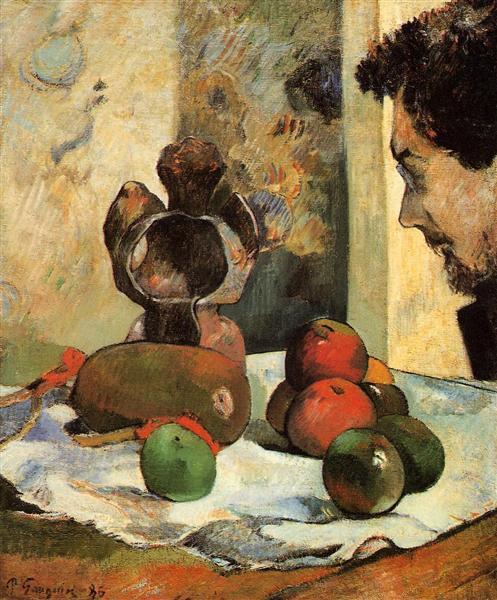Beskrivelse
Paul Gauguin's "Still Life with Profile of Laval" (1886) represents a fascinating convergence between the tradition of still life and the search for an aesthetic expression that challenges contemporary conventions. In this painting, the artist presents us with an array of objects that, although apparently simple, encompass a profound symbolism and an innovative use of color and form.
The composition of the work is remarkably balanced. In the centre, we highlight a schematic profile representing Émile Bernard, a contemporary and friend of Gauguin, which functions as a bridge between the viewer and the objects that surround him. This profile is not simply a portrait; it acts as a window towards introspection, establishing a silent dialogue between the figure and the still life that surrounds him. The figure, outlined with a simple and energetic stroke, leaves a mark on the canvas that seems to invite a deeper reading of the objects that accompany it.
The still life elements are equally significant. Gauguin includes fruits, flowers and other everyday objects that are arranged with an almost ritualistic sense. Each element is deliberately selected and placed, contributing to an atmosphere of calm and contemplation. The colour palette employed is characteristic of Gauguin's style; vibrant, saturated tones coexist with more muted colours, creating a dialogue between light and shadow that intensifies the sense of depth and three-dimensionality on a two-dimensional plane.
The choice of colours also reveals Gauguin’s mastery of evoking emotion. Warm yellows and deep greens contrast with neutral backgrounds, suggesting an almost tactile texture that makes objects seem to leap off the canvas. This ability to manipulate colour is a fundamental aspect of his work, moving away from naturalistic representation towards a poetic and emotional dimensionality.
Gauguin's style, which is part of the search for symbolism and post-impressionism, is manifested in this work as a rejection of mundane realities. The still life becomes an act of visual meditation, where the objects are not mere ornaments, but insinuations of broader narratives, imbued with introspection. The work reflects the influences of Japanese art and modern-era painting, elements that Gauguin incorporated into his own artistic practice.
It is interesting to note how this work fits into the development of Gauguin's style, who would later move to Polynesia in search of new sources of inspiration. Although "Still Life With Profile Of Laval" belongs to his period in France, it already anticipates his tendency towards the use of colour and symbolic forms that would characterise his later work. Gauguin often used his works as means to express and explore his own identity and the culture that surrounded him, and this painting is no exception.
When viewing “Still Life with Profile of Laval,” the viewer is invited on a visual journey that challenges the superficiality of the painted object, delving into an emotional experience that resonates beyond the frame. This work not only reflects Gauguin’s technical and creative skill, but also establishes an enduring dialogue between art and viewer, making it a timeless testament to art’s ability to capture the essence of human existence.
KUADROS ©, a famous painting on your wall.
Hand-made oil painting reproductions, with the quality of professional artists and the distinctive seal of KUADROS ©.
Painting reproduction service with satisfaction guarantee. If you are not completely satisfied with the replica of your painting, we will refund 100% of your money.

